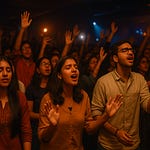The Maa Kali Temple in Jamui, Bihar, stands as a beacon of faith, spirituality, and centuries-old devotion. Although the exact historical records are limited, local traditions and folklore suggest that the temple's origin dates back several hundred years, deeply rooted in the Shakti tradition of Hinduism.
It is widely believed that this sacred site was established after a divine vision experienced by local villagers or sages, where Goddess Kali appeared in dreams and commanded the establishment of her shrine. Over the centuries, the temple has been nurtured and revered by the local community, growing from a modest shrine into a major center of devotion.
Many legends suggest that Maa Kali manifested here to protect the land from evil forces, and ever since, the temple has remained a source of spiritual strength for the devotees.
🏛️ Foundation and Architecture
The temple showcases traditional North Indian temple architecture, with simple yet powerful design elements that prioritize the divine presence over grandiose construction.
The sanctum sanctorum (Garbhagriha) houses a majestic black stone idol of Maa Kali, often depicted with a fierce yet compassionate expression, symbolizing the duality of destruction and motherly love.
The temple's outer walls and entrance are adorned with symbols of protection, Shakti Yantras, and paintings of Maa Kali slaying demons.
The atmosphere within the temple is mystical — dim lights, incense smoke, rhythmic chanting — evoking a deep spiritual connection.
The modest yet powerful architecture draws the devotee’s attention not to the material structure but toward the intense spiritual energy the temple radiates.
🕉️ Rituals, Puja, and Aarti
Daily Rituals
The day at Maa Kali Temple begins with the Mangala Aarti (early morning prayer) around 5:00 AM, where devotees gather to offer flowers, sweets, and prayers.
Throughout the day, individual pujas are performed where devotees offer red hibiscus flowers, vermilion (sindoor), coconuts, and sweets to Maa Kali.
Special Rituals
Tuesdays and Saturdays are considered especially auspicious for worshipping Maa Kali.
Animal sacrifice was historically practiced but has now been largely replaced with symbolic offerings like pumpkins and coconuts.
Devotees often perform deepam pujas (lamp offerings) and special mantra chanting for personal protection, success, and removal of obstacles.
Aarti Timings
The temple follows a disciplined spiritual routine marked by beautiful and energizing aartis throughout the day. The schedule is as follows:
Morning Mangala Aarti: The day at the temple begins early with the Mangala Aarti performed between 5:00 AM and 6:00 AM. This aarti sets a divine tone for the day, with the temple filled with the soft chants of mantras, ringing bells, and the serene aroma of incense.
Noon Bhog Aarti: Around 12:00 PM, the Bhog Aarti is performed when offerings of food (bhog) are made to the goddess. This midday ritual is symbolic of gratitude and devotion, seeking blessings for nourishment and well-being.
Evening Sandhya Aarti: The most spiritually vibrant experience happens during the Sandhya Aarti from 6:00 PM to 7:00 PM. As dusk falls, the temple resonates with the sounds of drums, conch shells, and devotional singing. The entire atmosphere becomes electric with faith and devotion, making it an unforgettable experience for devotees.
Attending these aartis offers a deep spiritual connection and fills the heart with profound peace and positivity.
The Evening Sandhya Aarti is a particularly enchanting experience, with bells ringing, devotees singing hymns, and the temple illuminated with oil lamps.
🛕 Temple Timing
Opening Time: 5:00 AM
Closing Time: 9:00 PM
Open All Days: Yes
Best Time to Visit: During Navratri, Kali Puja, and Diwali
🌟 Festivals and Major Events
Navratri: Celebrated with grand decorations, special pujas, and devotional music.
Kali Puja (Diwali Night): The most important festival here, with midnight prayers, tantric rituals, and cultural programs.
Deepavali: The temple premises light up with thousands of diyas (oil lamps).
Monthly Amavasya Nights: Special Kali homams (fire rituals) are performed for blessings and protection.
📍 How to Reach Maa Kali Temple, Jamui
By Rail:
Nearest Railway Station: Jamui Railway Station (4-5 km from the temple)
Well-connected by major trains from Patna, Howrah, Delhi, and other major cities.
By Road:
Jamui is well-connected by road with Patna, Gaya, Bhagalpur, and other towns.
Regular buses, taxis, and auto-rickshaws are available.
By Air:
Nearest Airport: Patna Airport (around 150 km)
Taxis and buses are available from the airport to Jamui.
🛌 Where to Stay
Hotels in Jamui: Multiple budget and mid-range hotels are available.
Dharamshalas (Pilgrim Guesthouses): Available near the temple for economical stays.
Best to book accommodation during festival seasons in advance.
🧭 Nearby Attractions
When visiting the Maa Kali Temple in Jamui, you can also explore several other significant and beautiful places located nearby:
Simultala Hill Station: Situated about 30 kilometers from Jamui, Simultala is renowned for its breathtaking natural beauty, serene environment, and picturesque hill views. It is a perfect place for those seeking peace and a refreshing retreat amidst nature.
Giddheshwar Temple: Located approximately 15 kilometers away, the Giddheshwar Temple is dedicated to Lord Shiva. This sacred temple is perched atop a hill, offering not only spiritual vibes but also a panoramic view of the surrounding landscape. It is a popular site during the festival of Maha Shivaratri.
Munger Fort: Roughly 50 kilometers from Jamui, Munger Fort stands as a historical marvel with deep religious significance. The fort is associated with ancient Hindu mythology and houses several old temples and relics. It is a perfect place for history enthusiasts and spiritual seekers alike.
Kali Pahar (Kali Hills): Only about 10 kilometers from the Maa Kali Temple, Kali Pahar is a naturally beautiful landscape closely associated with the legend of Maa Kali herself. The area is known for its rugged beauty and serves as a quiet place for meditation and nature walks.
Each of these nearby destinations adds to the charm of your spiritual journey, offering a blend of devotion, history, and natural splendor around Jamui.
✨ Spiritual Significance
Maa Kali represents Shakti, the cosmic energy that nurtures and destroys for renewal.
Worshipping here is believed to remove negative influences, shield devotees from evil, and grant success and inner strength.
Many devotees claim personal transformations — from healing illnesses to overcoming life's challenges — after visiting the temple.
The vibrations within the temple are often described as powerful yet soothing, making it not just a place of prayer, but of deep inner awakening.
🛤️ Best Time to Visit
October to March: Pleasant weather and major festivals like Navratri and Kali Puja are celebrated.
Navratri Festival: Experience the temple at its most vibrant, with cultural programs, bhajan-kirtans, and fairs.
📜 Tips for Visitors
Early Morning Visit: Recommended for peaceful darshan.
Traditional Attire: Wearing Indian traditional clothing is appreciated within temple premises.
Participate in Aarti: Do not miss the evening aarti for a spiritually charged experience.
Local Offerings: Hibiscus flowers, coconuts, sindoor, and sweets are preferred offerings.
The Maa Kali Temple in Jamui is not just a structure of bricks and stones, but a living powerhouse of faith, where centuries of devotion still vibrate in every corner. Whether you seek protection, blessings, spiritual growth, or just the peace of a sacred atmosphere, this temple offers a deeply enriching experience.
Visiting the temple is akin to reconnecting with the primal energy of the universe — fierce yet compassionate, fearsome yet motherly.
If you ever find yourself in Bihar, Maa Kali Temple, Jamui, should definitely be on your list of spiritual destinations.
"Jai Maa Kali!" 🚩🌟










